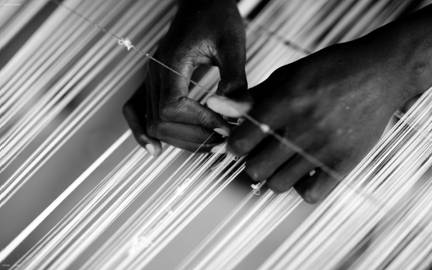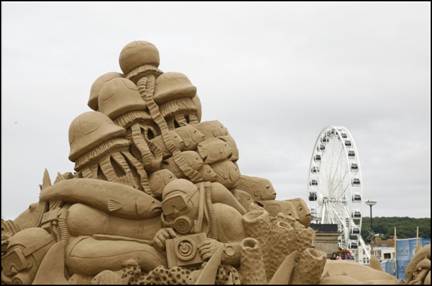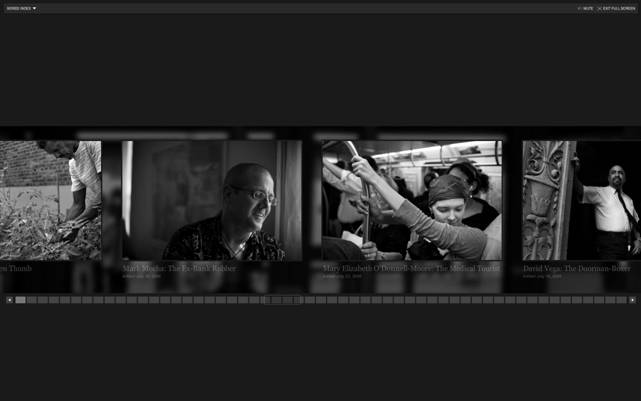Multimedia Story Telling (Howard Bagshaw)
In light of the decision by the RPS to review the range and extent of “Time Based Media” (horrible title – we must think of something snappier), I’ve had a look around the Internet at what is being done there.
I don’t know if you’ve come across ‘multimedia storytelling’ but it is getting to be big in the press. Recognising that the world is moving away from the printed medium towards internet access of news, a number of news providers and others are capitalising on the ability to present their stories as video or AVs. It is seen as the ‘new thing’ and some are producing very interesting sequences.
 Have a look for example at a sequence produced by a Danish AV production house called Bombay Flying Club at www.bombayfc.com/streetlight_uk/ It looks at the plight of sections of the community in Addis Ababa and at the response of one group to this situation. OK, it’s probably a bit long, but it is a telling story produced using excellent monochrome images. Have a look for example at a sequence produced by a Danish AV production house called Bombay Flying Club at www.bombayfc.com/streetlight_uk/ It looks at the plight of sections of the community in Addis Ababa and at the response of one group to this situation. OK, it’s probably a bit long, but it is a telling story produced using excellent monochrome images.
(image Poul Madsen / Bombay Flying Club)
The BBC also produce what they call ‘Audio Slideshows’ for use on their website. Promoting an exhibition, this slideshow for example gives a view of the life of Siegfried Sassoon: www.bbc.co.uk/news/uk-10714688 . Searching for audio slideshows on the BBC site will lead you to a huge number, all of very similar style.
 A sequence that is well worth looking at is about sandcastles. It was made in a couple of days, by two people on a training course run by an organisation called DuckRabbit. Incidentally, they call the medium ‘Photofilms’ A sequence that is well worth looking at is about sandcastles. It was made in a couple of days, by two people on a training course run by an organisation called DuckRabbit. Incidentally, they call the medium ‘Photofilms’
http://duckrabbit.info/blog/2009/07/zen-and-the-art-of-sandcastles-duckrabbit-training/
Or have a look at the New York Times site called ‘One in 8 million’ where we can see brief glimpses of the lives of some residents of New York. How about that for an idea? A two minute glimpses of the life of someone local, someone you know, and someone special. Have a look at www.nytimes.com/packages/html/nyregion/1-in-8-million/index.html

The software that seems to be most commonly used to produce these sequences is called Soundslides (http://soundslides.com/ ) and costs $70. I haven’t used the software, but it seems to be used because it produces work quickly and exports directly as Flash files, which can easily be incorporated into web pages. Their site gives info, but also has a good forum, (http://forums.soundslides.com/viewforum.php?id=12 ) with links to recently created sequences, similar to that found on the PTE forum.
So what do you notice about many of the sequences, compared with those we produce, probably using PTE? Perhaps most noticeable are the transitions between images, which are almost universally half-second dissolves, perhaps that’s a limitation of the software. Maybe because of that, little attempt is made to use the ‘third image’, they are sequential slide shows.
However, in most examples of the genre, the power of the audio track is apparent. This is not surprising as most sequences are documentary in style and make extensive use of interviews, something we see less of in our AV sequences.
Another aspect of published ‘sequences’ is the inclusion of some video clips, see for example http://bombayfc.com/42/ which shows a marathon in Copenhagen. Does the video add to the sequence? Purists might feel that the same ambiance could be achieved with stills. Will we see video included in our AV sequences? The ability of cameras such as the Canon 5D MkII to produce quality video is having an effect on the commercial world and Igor has recently announced that version 7 of PTE will allow the inclusion of HD video.
What I’ve also discovered is that there is a plethora of web material about story telling in this media. I was delighted to discover this, as I feel that I’m often lacking in the basic theory of making AVs, not the technical bits you understand, but the accepted practice in story telling. Have a look at http://www.inms.umn.edu/elements/ for example
So what can we gain from this genre? I suppose that is down to your view of AV and your preferred style. But if you have an interest in documentary style AVs then you might find inspiration on the web. At least these sequences are fairly accessible if you have a decent broadband connection.
Other links (and please let me know if you find other interesting sites)
http://link.brightcove.com/services/player/bcpid55376371001?bctid=57141973001
http://www.condition-critical.org/map/
http://www.asiasociety.org/onthinnerice
http://www.newyorker.com/online/multimedia/2009/10/05/091005_audioslideshow_riogangster
http://www.theglobeandmail.com/news/world/behind-the-veil/
http://www.condition-critical.org/map/
http://www.tampabay.com/specials/2009/photo_galleries/hardscrabble/
http://duckrabbit.info/2009/08/audio-slideshow-lisa-hogben-v-stevie-smith/
http://duckrabbit.info/blog/2009/07/zen-and-the-art-of-sandcastles-duckrabbit-training/
http://duckrabbit.info/2010/03/condition-critical/
http://www.nytimes.com/interactive/2010/03/21/books/20100321-JAZZLOFT-AUDIOSS/index.html#
http://www.latimes.com/news/local/la-me-teachers-boy-ss,0,3436771.htmlstory
http://www.burnmagazine.org/
http://www.nytimes.com/packages/html/nyregion/1-in-8-million/index.html#
http://www.inms.umn.edu/elements/
Proshow sequence with video http://www.photodex.com/gallery/view?px=2492 |
